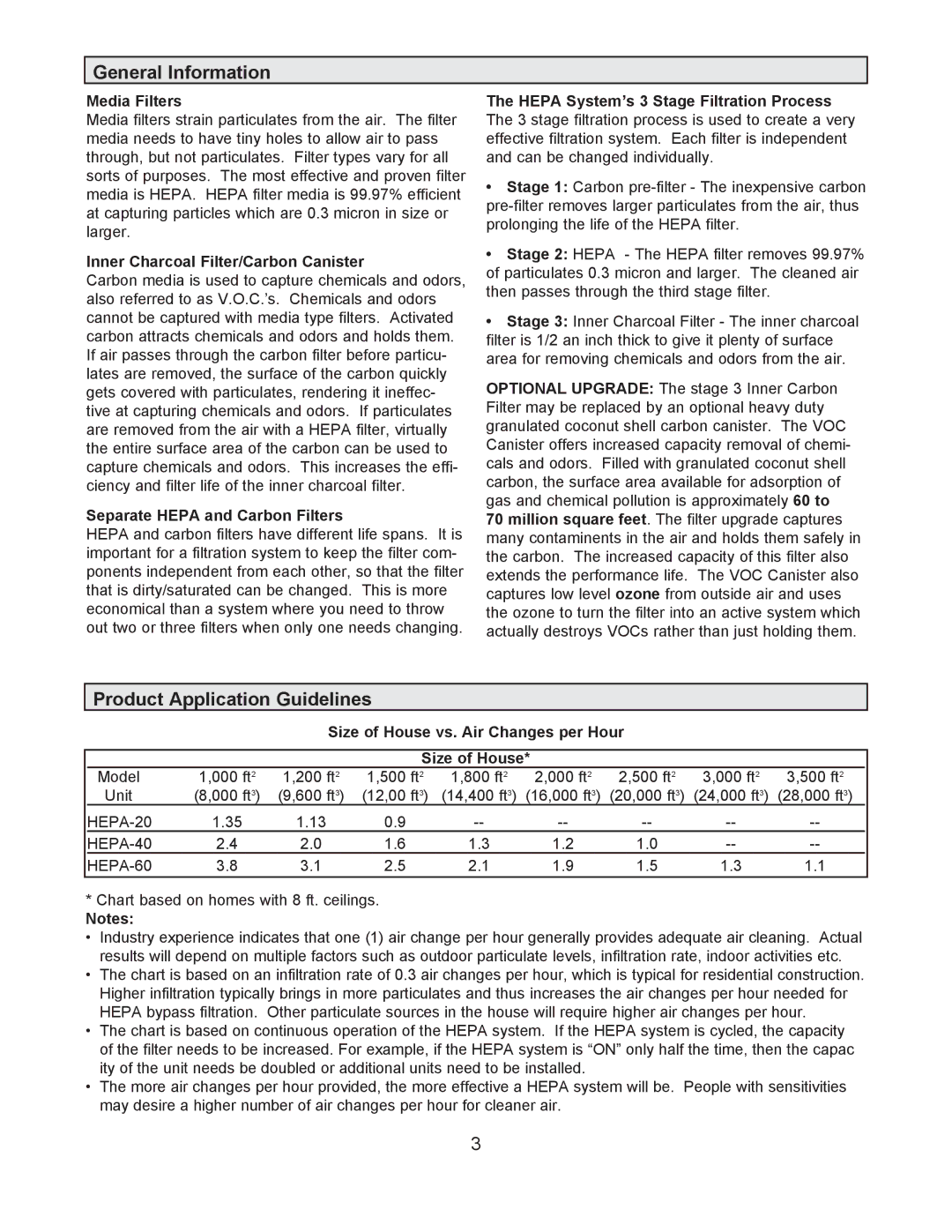
General Information
Media Filters
Media filters strain particulates from the air. The filter media needs to have tiny holes to allow air to pass through, but not particulates. Filter types vary for all sorts of purposes. The most effective and proven filter media is HEPA. HEPA filter media is 99.97% efficient at capturing particles which are 0.3 micron in size or larger.
Inner Charcoal Filter/Carbon Canister
Carbon media is used to capture chemicals and odors, also referred to as V.O.C.’s. Chemicals and odors cannot be captured with media type filters. Activated carbon attracts chemicals and odors and holds them. If air passes through the carbon filter before particu- lates are removed, the surface of the carbon quickly gets covered with particulates, rendering it ineffec- tive at capturing chemicals and odors. If particulates are removed from the air with a HEPA filter, virtually the entire surface area of the carbon can be used to capture chemicals and odors. This increases the effi- ciency and filter life of the inner charcoal filter.
Separate HEPA and Carbon Filters
HEPA and carbon filters have different life spans. It is important for a filtration system to keep the filter com- ponents independent from each other, so that the filter that is dirty/saturated can be changed. This is more economical than a system where you need to throw out two or three filters when only one needs changing.
The HEPA System’s 3 Stage Filtration Process The 3 stage filtration process is used to create a very effective filtration system. Each filter is independent and can be changed individually.
•Stage 1: Carbon
•Stage 2: HEPA - The HEPA filter removes 99.97% of particulates 0.3 micron and larger. The cleaned air then passes through the third stage filter.
•Stage 3: Inner Charcoal Filter - The inner charcoal filter is 1/2 an inch thick to give it plenty of surface area for removing chemicals and odors from the air.
OPTIONAL UPGRADE: The stage 3 Inner Carbon Filter may be replaced by an optional heavy duty granulated coconut shell carbon canister. The VOC Canister offers increased capacity removal of chemi- cals and odors. Filled with granulated coconut shell carbon, the surface area available for adsorption of gas and chemical pollution is approximately 60 to
70 million square feet. The filter upgrade captures many contaminents in the air and holds them safely in the carbon. The increased capacity of this filter also extends the performance life. The VOC Canister also captures low level ozone from outside air and uses the ozone to turn the filter into an active system which actually destroys VOCs rather than just holding them.
Product Application Guidelines
Size of House vs. Air Changes per Hour
Size of House*
Model | 1,000 ft2 | 1,200 ft2 | 1,500 ft2 | 1,800 ft2 | 2,000 ft2 | 2,500 ft2 | 3,000 ft2 | 3,500 ft2 |
Unit | (8,000 ft3) | (9,600 ft3) | (12,00 ft3) | (14,400 ft3) | (16,000 ft3) | (20,000 ft3) | (24,000 ft3) | (28,000 ft3) |
1.35 | 1.13 | 0.9 | ||||||
2.4 | 2.0 | 1.6 | 1.3 | 1.2 | 1.0 | |||
3.8 | 3.1 | 2.5 | 2.1 | 1.9 | 1.5 | 1.3 | 1.1 |
*Chart based on homes with 8 ft. ceilings.
Notes:
• Industry experience indicates that one (1) air change per hour generally provides adequate air cleaning. Actual results will depend on multiple factors such as outdoor particulate levels, infiltration rate, indoor activities etc.
• The chart is based on an infiltration rate of 0.3 air changes per hour, which is typical for residential construction. Higher infiltration typically brings in more particulates and thus increases the air changes per hour needed for HEPA bypass filtration. Other particulate sources in the house will require higher air changes per hour.
• The chart is based on continuous operation of the HEPA system. If the HEPA system is cycled, the capacity of the filter needs to be increased. For example, if the HEPA system is “ON” only half the time, then the capac ity of the unit needs be doubled or additional units need to be installed.
• The more air changes per hour provided, the more effective a HEPA system will be. People with sensitivities may desire a higher number of air changes per hour for cleaner air.
